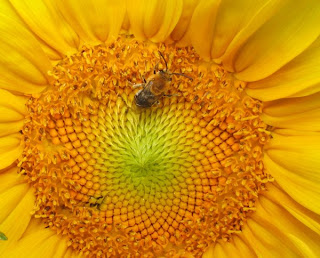 |
| Bumble bee on pumpkin flower © Beatriz Moisset. 2013 |
As I mentioned in the previous post, many assume
that the honey bee is responsible for all that pollination. Not so! We must
remember that the domesticated bee was brought to this continent in the 1600s by
European colonists. It was introduced to California
even later, in the 1850s. Who did all the pollination before? Was it as
necessary then as it is now?
I suspected that the "one bite out of three" was
just as valid before the introduction of the honey bee as it is now. I decided
to learn about the pollinators that did all the work in pre-Columbian days. First,
I searched for information on Native Americans' food plants and then studied
how these plants were pollinated. You can immerse yourself on Daniel Moerman's
list of 1,500 plants (Native American Ethnobotany Database) or read a shorter list of plants used by peoples of the North East. I will
limit myself to painting a picture with an extremely broad brush starting with
the most important food sources.
In large part of North America
the native peoples cultivated the so called Three
Sisters: corn, squash and beans. Corn is wind pollinated. But the other two
need the help of bees. The squash bee and a variety of solitary bees and bumble
bees pollinate the so called vine crops: pumpkins, squash and other gourds.
Beans, all varieties of them, also need the help of native bees and bumble bees
to produce a crop.
 |
| Bumble bee on sunflower © Beatriz Moisset. 2013 |
 |
| Studying the pollinators of camas lilies in Oregon © Beatriz Moisset. 2013 |
 |
| Common milkweed was eaten by Native Americans after removing the toxins © Beatriz Moisset. 2013 |
In South America, all the
members of the tomato and potato family are insect pollinated. Figs, cashew
nuts, cacao and a number of tropical fruits also require the services of
pollinators, not just insects but even hummingbirds and bats.
Of course, Native Americans ate animals in addition to plants. Some of this
food also depended indirectly on pollinators. I will limit myself to one
example, that iconic bird that represents one of the early interactions between
European colonists and natives: the turkey. It feeds, in part, on insect-pollinated
berries, crabapples, seeds, roots and nuts.
 |
| Wild turkeys © Beatriz Moisset. 2013 |






